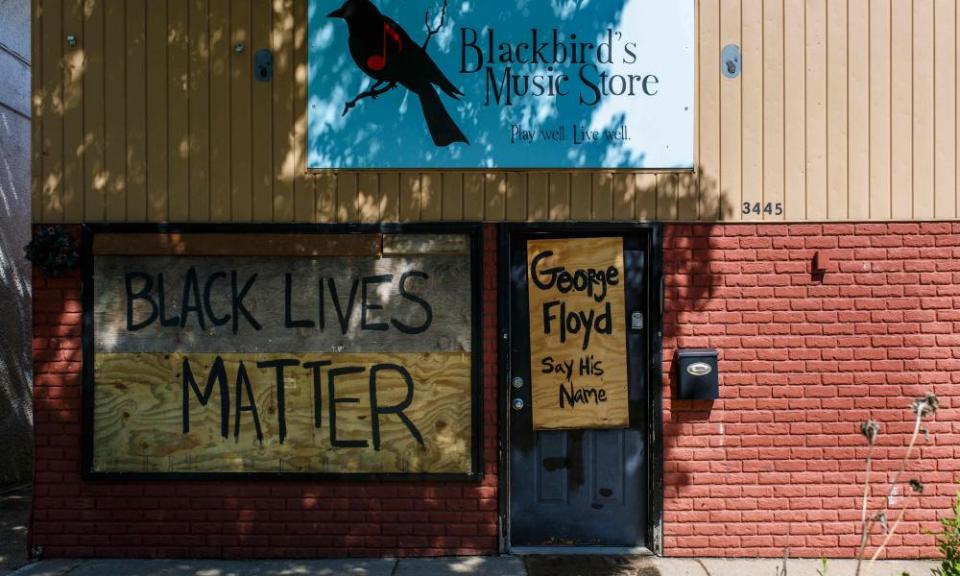The governor says Minneapolis is 'under assault'. Who is behind the protests?
Minnesota’s governor, Tim Walz, blamed “elements” of domestic terrorism, ideological extremism and international destabilisation for what he called an assault on Minneapolis. Black community leaders suggested the destruction was led by white supremacists and anarchists intent on destroying the state.
Related: George Floyd: governor's vow to reclaim streets rings hollow on night of chaos
But if alien revolutionaries could be found among the huge crowds who tore apart shops and businesses along a two-mile stretch of southern Minneapolis following the police killing of George Floyd, there were also plenty of people driven by nothing more than visceral anger and opportunism.
Following Friday night’s rioting, Walz said Minneapolis and neighbouring St Paul were “under assault” from people from outside the cities. He suggested up to 80% of those looting and setting fire to buildings were from other places.
“The situation in Minneapolis is no longer in any way about the murder of George Floyd,” he said. “It is about attacking civil society, instilling fear and disrupting our great city.”
Peggy Flanagan, the lieutenant governor, blamed those she said do not have the community’s interests at heart.
“There are white supremacists there. There are anarchists. There are people who are burning down institutions that are core to our identity,” she said

Emilia Gonzalez Avalos, the director of the community organisation Navigate MN, said outsiders came to “cause more harm and pain in places where there’s already harm and pain”. Other community leaders blamed those they said were intent on overthrowing the government. At the justice department in Washington, the attorney general, William Barr, made similar points.
The narrative of outside agitators stirring up trouble was not without truth. Young white people dressed in black, who at times did not seem to know their way around the city, were among the most aggressive with the police. They worked in groups, and spray-painted the most political graffiti, beyond the calls for justice for George Floyd or the ubiquitous “Fuck the police”.
But blaming ideological agitators is also politically convenient, not least because Walz was severely embarrassed by the failure of the police and national guard to enforce a curfew he said would end the destruction.
It is also untrue.
Very large numbers of people attacking buildings and looting were from the city, if not from the Lake Street neighbourhood that suffered most. They were not there to overthrow anything. Many seemed more intent on dragging home the contents of Target or the liquor store, or just venting their anger by taking it out on panes of glass.
As the protests have swirled around south Minneapolis, different groups have stood out. The young white people working in clusters, frequently wearing backpacks. Local people, many African American but also whites and Latinos, who are there to keep the focus firmly on the demand for justice for George Floyd, and particularly a call for the arrest of all the officers involved in his death. And groups of mainly young men, both black and white, who lead the looting.

Sometimes they protest together. Those the governor called anarchists were often seen alongside the men smashing up shops, but did not necessarily stay to plunder. Protesters looking for justice rallied alongside the young white crowd dressed in black outside the fifth precinct police station.
If there was some well-coordinated scheme to take apart Minneapolis, there was also a considerable amount of opportunism by large numbers of people who couldn’t believe their luck. Some arrived in cars with Minnesota license plates to load up with goods from Target. A line of vehicles drew up at the liquor store to sling in cases of beer and spirits. Others wheeled away what they could in shopping trolleys.
What is different in the city is the scale of the destruction.
While the protests in Ferguson, Missouri, six years ago over the police killing of Michael Brown involved some looting and burning of buildings, mostly they centred around nightly face-offs with the police.
Related: Policing in the US is not about enforcing law. It’s about enforcing white supremacy | Paul Butler
Besides the storming and wrecking of the third precinct police station on Thursday, two nights of rioting have left a stretch of more than two miles of Lake street battered and burned. Scores of shops and businesses were destroyed, and many more damaged, as barely a block went unscathed. In parts, entire rows of shops were razed by fire. Other places escaped with no more than broken windows.
Gas stations, banks and auto parts stores were burned to the ground. Sprawling retail stores were comprehensively plundered. Pharmacies were a favoured target. But many of the stores hit were small family-owned concerns. Barbers, restaurants, electronics dealers, a car wash.
The raiding of a large liquor store helped turn the riot into a party for some, as music blared and cars drag raced along Lake Street.


